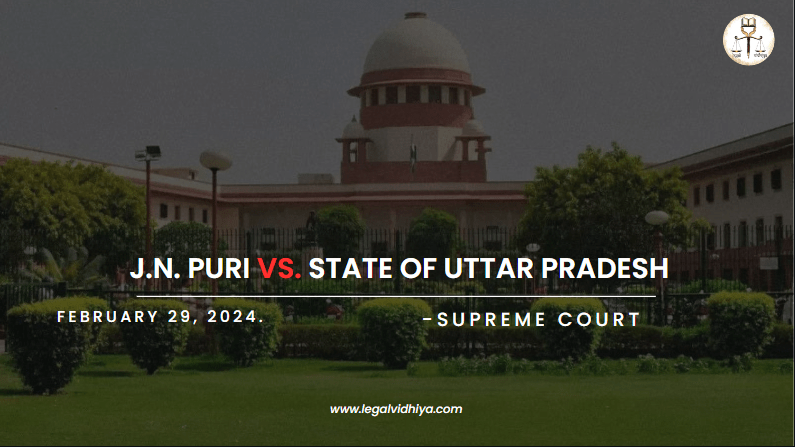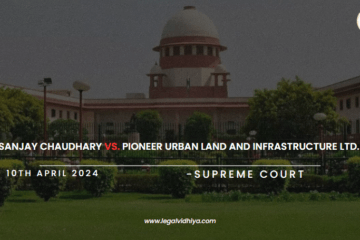
CITATION- 2024 INSC 64
DATE OF JUDGMENT- FEBRUARY 29, 2024.
COURT- THE SUPREME COURT OF INDIA
APPELLANT- J.N. PURI
RESPONDENT- STATE OF UTTAR PRADESH (NOW STATE OF UTTARAKHAND) & ORS.
BENCH- B.R. GAVAI, SANDEEP MEHTA
INTRODUCTION
The case of J.N. Puri vs. State of Uttar Pradesh revolves around a legal dispute related to the acquisition of land by state authorities in the state of Uttar Pradesh, India. A writ petition was filled by the appellant, J.N. Puri challenged the acquisition of his land in 1987. However, the petition was dismissed in 1992. J.N. Puri filed applications seeking restoration of the writ petition, citing procedural irregularities and a belief that the matter was still pending due to certain observations made in proceedings. The case reached the Uttarakhand High Court, J.N. Puri’s applications for restoration were rejected, which led to the submission of further appeals and review applications. This case highlights the complexities involved in land acquisition disputes, and the significance of legal actions and process in addressing such matters within the Indian legal system.
FACTS OF THE CASE
- A writ petition was filed by the appellant, J.N. Puri (Writ Petition(M/B) No. 156/1987) before the High Court of Allahabad in 1987. This petition challenged the acquisition of Puri’s land by the state authorities.
- The writ petition filed by Puri was dismissed by the High Court of Allahabad on February 26, 1992. The reason behind dismissal was failure to actively pursue the case.
- Following the dismissal of the writ petition, an application for restoration was filled by the appellant, J.N. Puri on March 23, 1992. In this application, certain reasons such as the absence of his advocate’s name on the cause list and the potential conflict of interest involving one of the judges were listed by the appellant.
- The initial restoration application, remained unresolved. In response to the unresolved matter, Puri filed another application in 1999, which the Uttarakhand High Court treated as a restoration application. However, this application was rejected in 2001.
- J.N. Puri claimed to have believed that his writ petition was still pending due to certain observations made in the proceeding. However, it was later discovered through an RTI query that the writ petition had been dismissed in 1992.
- In response to the dismissal of his restoration application, J.N. Puri, the appellant filed a restoration application, seeking condonation of delay. Both these applications were dismissed by the High Court of Uttarakhand in the years 2019 and 2020.
ISSUES RAISED
- Whether the dismissal of the appellant’s writ petition was justified, considering the circumstances surrounding the filing of restoration applications?
- Whether the High Court erred in rejecting the appellant’s subsequent applications for restoration and review?
CONTENTIONS OF APPELLANT
- The appellant puts forward the argument that the application for restoration of the writ petition was filed within the prescribed time limit.
- The appellant contends that there were procedural irregularities in the handling of the case, which included the absence of the appellant’s advocate’s name on the cause list and the potential conflict of interest involving one of the judges. These irregularities affected the appellant’s ability to pursue the case effectively.
- The appellant states that he genuinely believed that his writ petition was still pending, based on certain observations made in a proceeding. This belief influenced the appellant’s actions and decision making.
- Efforts to Pursue Restoration were made on the appellant’s part. The appellant argues that these efforts were genuine and should be considered by the court.
CONTENTIONS OF RESPONDENT
- The respondent argued that the dismissal of the appellant’s writ petition was in accordance with the procedure followed in the court. It was asserted that the appellant failed to actively pursue the case, which lead to its dismissal.
- The respondent contented that the appellant’s claim regarding the timeliness of the restoration applications is wrong. It was argued from the respondent’s side that the applications were filed after significant delays and were rightly rejected by the court.
- It was led the before the court that there is an absence of Merit in the application. The respondent asserted that the appellant’s applications for restoration lacked merit and did not provide sufficient grounds for reconsideration of the dismissed writ petition. Another argument was posed that the court’s decisions to reject these applications were justified based on the facts and circumstances of the case.
- The respondent emphasized on the decision taken previously, including the dismissal of the writ petition and the rejection of restoration applications. They argued that the appellant had ample opportunity and time to pursue legal remedies but failed to do so effectively.
JUDGEMENT
The judgment overturned the orders of the High Court and directed the restoration of the appellant’s writ petition, showing the importance of procedural regularity and providing an opportunity for the case to be reviewed on its merits. In the Supreme Court finding it was seen that the application for restoration of the writ petition was filed within the prescribed time limit of one month from the date of dismissal, overruling the decision taken by the High Court. This fact was further, acknowledged in the counter affidavit filed by the State of Uttar Pradesh/Uttarakhand. The procedural irregularities in the handling of the case, including the absence of the appellant’s advocate’s name on the cause list and the potential conflict of interest involving one of the judges were taken into consideration by the supreme court. It was seen, these irregularities hindered the appellant’s ability to pursue the case effectively. The appellant genuinely believed that his writ petition was still pending based on certain observations made in a proceeding. This belief influenced the appellant’s actions and decisions regarding the restoration of the petition. Efforts were made by the appellant to pursue the restoration of the writ petition, including the filing of subsequent applications seeking restoration and review. The Supreme Court felt these efforts genuine and thought that, these should have been considered by the High Court. The Supreme Court concluded that the High Court was incorrect in holding this decision, and the restoration application was submitted with a delay of seven years. The application was filed within the prescribed time limit of one month, as admitted in the counter affidavit filed by the respondent. Given the circumstances and the appellant’s claim to still possess the land under acquisition, the Court ordered the matter to be remitted to the High Court of Uttarakhand for restoration of the writ petition and expedited consideration on its merits.
ANALYSIS
The analysis of J.N. Puri vs. State of Uttar Pradesh underscores the significance of procedural regularity, timely legal actions, the role of judicial review, and ensuring access to justice in the legal process. Various complex and crucial aspects incurred while the case was proceeding in the court. One of the major things the case highlights is the necessity of courts to adhere strictly to procedural rules and ensure that all parties are given their rights. The appellant’s contention regarding the absence of his advocate’s name on the cause list and potential conflicts of interest among judges lays the importance of transparency and in court proceedings. Another important aspect of the case was the judicial review, as the judgment demonstrates the role of judicial review in rectifying errors made by the lower court rulings. The orders of the High Court were overruled and the restoration of the appellant’s writ petition was directed by the Supreme Court ensuring a fair reconsideration of the case. The case highlights the importance of access to justice. By remitting the case to the High Court for further considerations, the judgment seeks to uphold the principles of fairness and equity in the Indian legal system.
CONCLUSION
The case of J.N. Puri vs. State of Uttar Pradesh serves as a testament to the importance of procedural stability, timely legal actions, and access to justice within the Indian legal system. The Supreme Court’s judgment, overruling the judgement of the High Court and directing the restoration of the appellant’s writ petition, underscores the significance of ensuring fairness and stability in the legal proceedings. By giving a fair chance to the appellant’s application to be heard on merit, it reconstructs the justice and adherence to the Indian legal system. Furthermore, the case highlights the necessity for courts to carefully consider all relevant facts and provide parties with an opportunity for a fair hearing on the merits of their case.
REFERENCES
- https://main.sci.gov.in/supremecourt/2020/24776/24776_2020_3_1502_49957_Judgement_29-Jan-2024.pdf
- https://indiankanoon.org/doc/147819538/
- https://www.drishtijudiciary.com/current-affairs/intra-court-appeal-in-criminal-matters
This is written by Nyasa Tahim, student of Vivekananda Institute of professional studies (VIPS); Intern at Legal Vidhya.
Disclaimer: The materials provided herein are intended solely for informational purposes. Accessing or using the site or the materials does not establish an attorney-client relationship. The information presented on this site is not to be construed as legal or professional advice, and it should not be relied upon for such purposes or used as a substitute for advice from a licensed attorney in your state. Additionally, the viewpoint presented by the author is of a personal nature.






0 Comments